Dousing the Flames with Gasoline
By Colin Twiggs
September 19, 2007 1:00 a.m. ET (3:00 p.m. AET)
These extracts from my trading diary are for educational purposes and should not be interpreted as investment advice. Full terms and conditions can be found at Terms of Use.
Interest Rates
The Federal Reserve announced a half-percent cut in the targeted fed funds rate — not unexpected given the Fed's need to support the banking system, currently under stress from the collapse of the real estate bubble. Step back for a minute, however, and consider the bigger picture.
The current crisis is a result of the Fed allowing money supply to grow, post 2001, at a faster rate than the increase in national income (output). This has a fourfold effect:
- Inflation. Prices rise as more money chases the same quantity of goods.
- Savings decline. Investors receive less interest and their capital is eroded by inflation.
- Asset prices rise. Investors buy real assets as a hedge against inflation — and in anticipation of price increases due to inflation.
- Debt rises. Cheap money attracts new borrowers who compete to buy the now scarce real assets, further forcing up prices (as in the current real estate bubble).
Unfortunately expectations of further price increases soon become entrenched. There is no self-moderating mechanism in the market to bring rates and assets back to a happy equilibrium. In fact, the opposite is true. Expectations of price increases become self-reinforcing, attracting further speculators to the market and driving up prices faster and faster. As any stock market chartist, economist or biologist will tell you: no self-reinforcing cycle can last. The market has to collapse when it runs out of new speculators to attract or when existing speculators attempt to cash in their paper profits. Like a giant Ponzi scheme, it can only end in tears.
The danger is that the further the Fed allows rates and prices to stray from their true equilibrium, the greater the hardship required to bring them back. Like a bushfire, the conflagration can easily get out of hand, taking on a life of its own. Yet we are assured not to feel concerned. We are in safe hands. The problem is under control. And the experts have come up with a simple (and painless) solution: just increase the money supply and the problem will go away.
The problem is not a failure of the market. The problem is the absence of a free market. Rates have been distorted by the Fed (and other central banks) for so long that the free market cannot function to establish an equilibrium interest rate that matches supply and demand. So the economy is condemned to perpetual boom and bust cycles, with all the hardship that that entails.
Gold
Gold is not the only store of value, but it is one of the most portable, and is likely to benefit from a depreciating dollar. Spot gold is rising steeply, headed for a test of resistance at the 2006 high of $730. In the long term, expect the dollar price of gold to increase further.
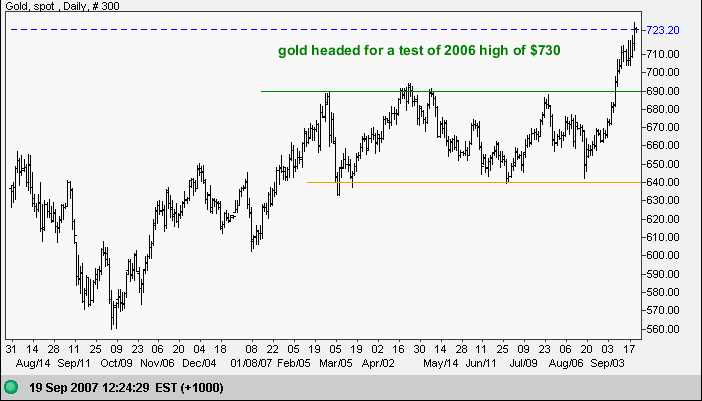
Source: Netdania
Crude Oil
December Light Crude broke through resistance at $76/barrel and is headed for a test of the August 2006 high of $80.25. Narrow consolidation below the resistance level would be a bullish sign.
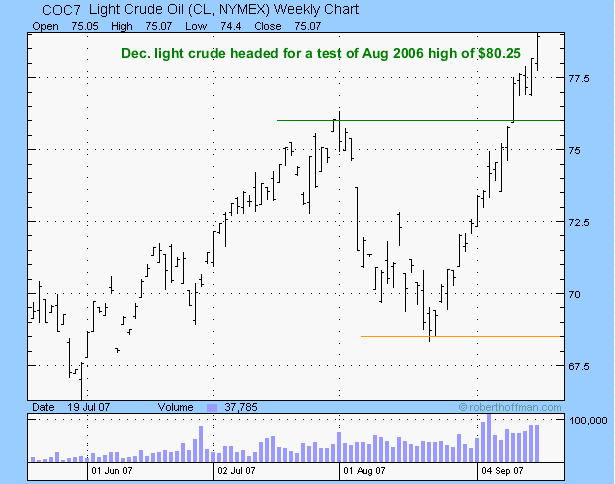
Currencies
The euro is establishing new highs against the dollar, after breaking through resistance at $1.37. The primary up-trend continues, helped by a Fed rate cut that the ECB is unlikely to follow.
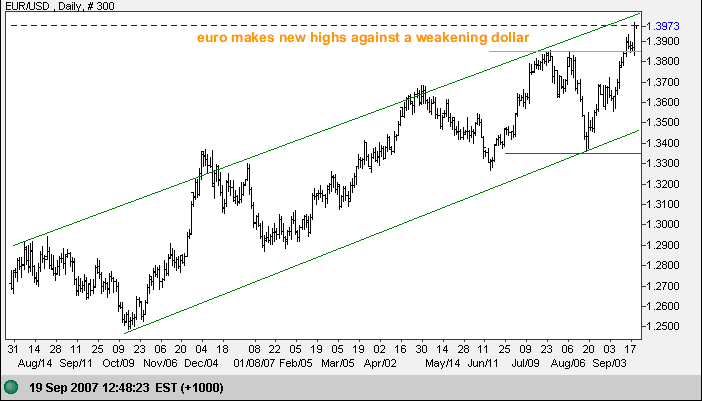
Source: Netdania
The dollar continues to consolidate against the yen. Expect further weakness as the rate differential decreases — and continuation of the primary down-trend.
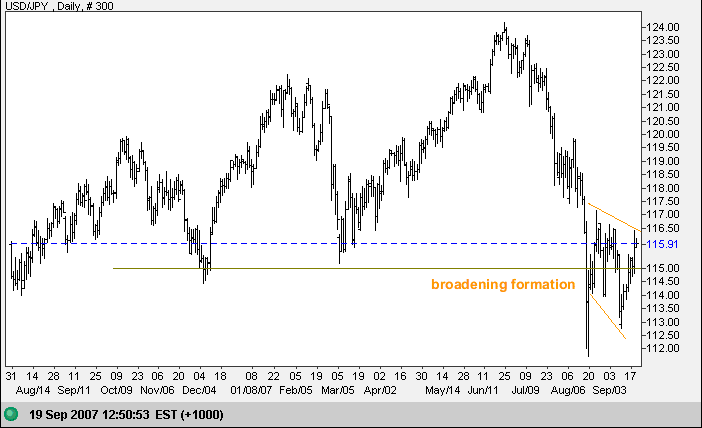
Source: Netdania
The Australian dollar is rallying strongly against the greenback after breaking through resistance at 0.8350. Further consolidation or retracement is likely, but the Aussie has established a strong up-trend that will be further fuelled by the latest rate cut. Reversal below the rising trendline, while not expected, would signal weakness.
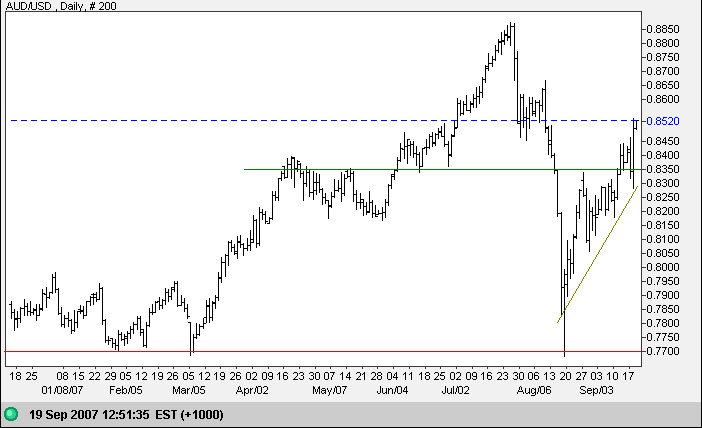
Source: Netdania
Treasury Yields
Ten-year treasury yields pulled back to test the new resistance
level of 4.50%. Respect would signal continuation of the
20-year (super cycle) down-trend, while recovery to above 4.50%
would indicate a false break.
The yield differential (10-year minus 13-week treasury yields)
is rising as short-term rates fall, easing pressure on bank
margins. However, concern over tightening bank credit and the
non-bank commercial paper market remains.
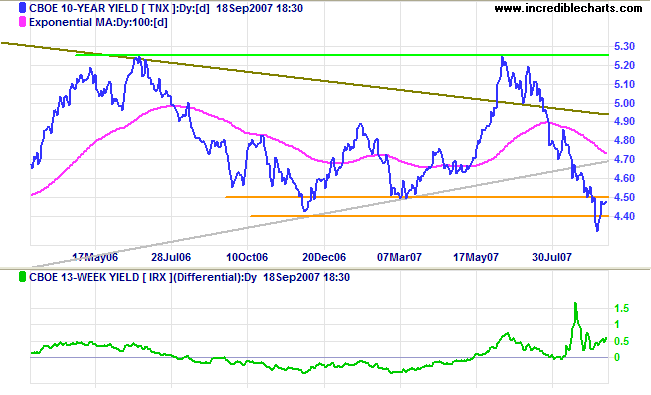
The fed funds rate recovered to 5.25%, but is now expected to fall, in line with the cut in the targeted rate to 4.75%. Short-term (3-month) treasury yields at 4.0% continue to reflect an extremely nervous and risk-averse financial market.
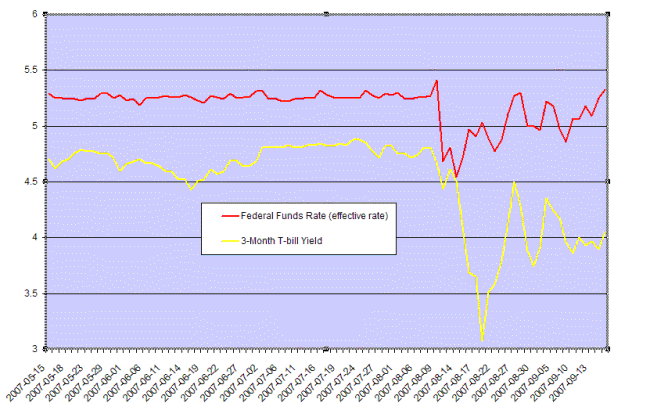
Expect some window-dressing as investment banks announce their third-quarter results. Goldman Sachs' sale of some of the family silver (environmental power company Horizon Wind Energy LLC) filled an estimated $1 billion hole in income from traditional business units. The full impact of the sub-prime crisis may take many months to unravel.
Stock Markets
The Dow Jones Industrial Average broke through resistance at 13500 on modest volume, signaling a test of resistance at 14000. Whether the fed rate cut gives sufficient impetus for the market to follow through to a new high (and resume the primary up-trend) remains to be seen. Twiggs Money Flow breakout above 0.08 signals medium-term accumulation.
I believe that the party is almost over — the market may have enough left for one more rally, but investors are likely to be more cautious and far readier to take profits rather than attempt to ride out further corrections.

The Nikkei made a failed break above 16000 and is now headed for a test of support at 15600. The primary down-trend continues.
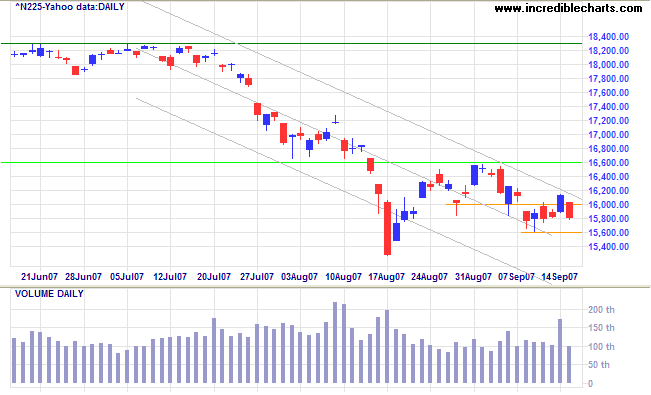
The FTSE 100 is consolidating between 6100 and 6400. Twiggs Money Flow signals accumulation: expect another test of resistance at 6400. Breakout above this level would signal that the down-trend has ended.
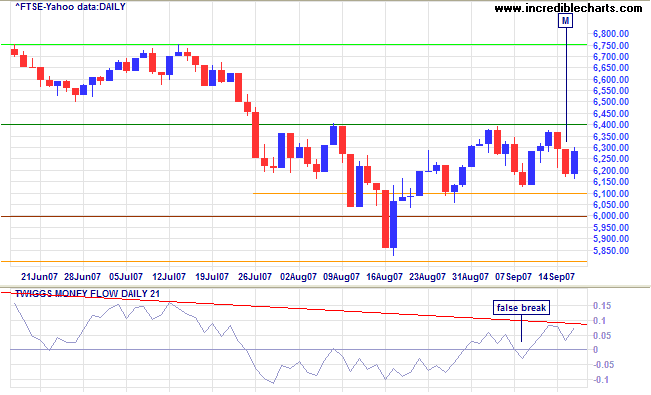
The Hang Seng and Shanghai Composite remain bullish. The ASX All Ordinaries is headed for a test of the all-time high of 6460, but, again, investors are likely to be more cautious.
Wright Model
Probability of recession in the next four quarters remains at a low 26 per cent according to the Wright Model. The model fairly accurately predicts recessions caused by a contraction of the money supply, but I suspect that it may not be as reliable in identifying the mischief caused by artificially low interest rates.
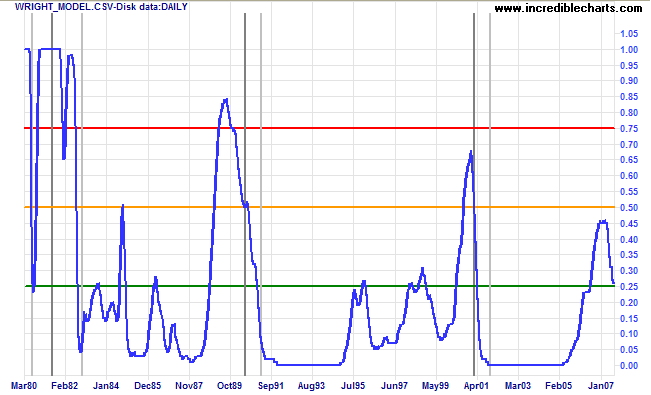
Engulfed by fear and suspicion, we try desperately to invent
ways out, plan how to avoid the obvious danger that threatens
us so terribly. Yet we're mistaken, that's not the danger
ahead: Another disaster, one we never imagined, suddenly,
violently, descends upon us, and finding us unprepared -
there's no time now - sweeps us away.
~ C. P. Cavafy: Things Ended
To understand my approach, please read Technical Analysis & Predictions in About The Trading Diary.

Author: Colin Twiggs is a former investment banker with almost 40 years of experience in financial markets. He co-founded Incredible Charts and writes the popular Trading Diary and Patient Investor newsletters.
Using a top-down approach, Colin identifies key macro trends in the global economy before evaluating selected opportunities using a combination of fundamental and technical analysis.
Focusing on interest rates and financial market liquidity as primary drivers of the economic cycle, he warned of the 2008/2009 and 2020 bear markets well ahead of actual events.
He founded PVT Capital (AFSL No. 546090) in May 2023, which offers investment strategy and advice to wholesale clients.
